
Better audience targeting for Financial Services: How to profitably run millions in Meta ad spend.

The landscape of financial services marketing has undergone a dramatic transformation over the last 12 years of my marketing career. In particular, since 2021 the shift in audience targeting strategies on platforms like Meta (formerly Facebook) has presented both challenges and opportunities for marketers in this sector.
A changing landscape for Meta (Facebook) advertising in Financial Services
In the early days of Meta (Facebook) advertising, marketers could pinpoint their audience with remarkable precision. Age, gender, interests, household income, and geography were all fair game. However, as concerns about privacy and discriminatory practices have grown, the ability to target specific demographics on Meta has been reduced.
This change has been quite impactful for financial services, such as debt consolidation and management firms. These companies previously thrived on the ability to target niche audiences with specific financial needs. With the removal of such targeting capabilities, the challenge has shifted from crafting the perfect campaign to ensuring that the right audience sees it.

Navigating Meta ad restrictions: Turning around a broken campaign and making it generate millions
In response to these changes, marketers have had to think outside the box, and at WebMechanix that happens to be our specialty. The reality of losing both third-party data and the ability to use cookies has forced the marketing arms of financial services companies to rely on first-party data. This data, provided directly by potential clients, has become the new cornerstone of audience targeting.
The significant challenge now lies in interpreting the information provided. Here’s how we met the challenge for our client working in debt consolidation and management.
The set up:
Already a leader in the market, this client had been running successful campaigns on Meta (Facebook) and Google for years. Spending around $100K a month, they were utilizing pinpoint targeting, demographic information, and essentially saying to these platforms, “I want someone with nine credit cards open and not that much income” and finding them. Then these successful campaigns stopped working!
Suddenly we’re able to target people less and less compared to what we used to do. A lot of that has to do with the rising awareness of privacy and changing discriminatory practices using targeting based on age, gender, or zip codes. These platforms are adjusting and marketing needs to adjust too.
Solving the problem:
The real problem was not the “Mad Men” challenge – coming up with the perfect campaign. We already had the perfect campaign but the ability to put it in front of the right people vanished. Without really good targeting anymore, what exactly could we lean on? The answer was using the first-party data this client already had on the people they served and the few data points (e.g. where they lived and how much they said they had in debt) that we were legally allowed to collect. This first-party data was fed back into the Meta ads and Meta now used this data to build a model that said “if people meet these criteria, they’re probably going to be pretty good. If they don’t meet these criteria, we can probably ignore them.”
“We already had the perfect campaign,
but the ability to put it in front of the right people vanished.”
Now, for Meta, for Google Ads, or for the other advertising methods that they were using, we didn’t have to punch in combinations of demographics information. We’d already found that. Instead we said, “Here’s a data point that we want you to use. Every time you get this data point from us, we want you to go and use that to find other people like that.” A shift from really narrow targeting to the perfect audience to “people in the United States over 18 years old…and have a pulse” makes any sane person believe that the marketing efforts would get worse, not better.
But when we accompanied that with this very specific piece of data that we were giving these platforms, we actually saw the opposite effect. Now, when you brought in an audience, your cost to reach that audience went down significantly.
The results:
Using this strategy you start to get:
- Cheaper traffic thanks to a broader audience allowing for lower CPMs.
- Increased reach because you’re saying, “Hey, I’m willing to target anybody in this space whatsoever.” But now the platform has the responsibility to use the data that you give it to go get you more of what you’ve asked for – in our client’s case, more of this very particular data point.
With this method, the platforms we were marketing on became very good placing our good creative that had worked for a long time in front of people matched to our data point. All at a lower cost than we did before.
Instead of only being able to spend $100,000 a month through these platforms to get a 10X return, suddenly we could spend a million, a million and a half, 2 million a month to get actually a higher rate of return because of that combination of factors – a better series of targeting through a data point and the lower cost of that traffic.

The power of data points in Financial Services marketing
The shift from demographic targeting to data point targeting may seem counterintuitive. However, the results we continue to see are surprisingly positive. By feeding these data points into advertising platforms, our clients reach a broader audience at a lower cost by forcing the platforms to effectively do the targeting work.
Instead of targeting a small, expensive audience, our clients are now reaching a larger, more cost-effective audience. Marketing campaigns for financial services (and other industries) are able to scale up, achieving higher returns on investment.
“Suddenly we could spend a million, a million and a half,
2 million a month to get a higher rate of return.”
The future of audience targeting in Financial Services
As privacy concerns continue to reshape the landscape, the importance of first-party data and data point targeting will only grow.
This shift represents a move from media buyers controlling the targeting to instead providing the data necessary to the platforms and letting the platforms do the targeting from that data. In that context, data-driven creative testing becomes a more important differentiator than ever.
Despite these new restrictions by Meta, Google and other ad platforms, the financial services sector now has a way to adapt and thrive. Our teams at WebMechanix are using first-party data and data points to deliver unprecedented performance to campaigns and industries that were struggling to make their marketing work before.
Most newsletters suck...
So while we technically have to call this a daily newsletter so people know what it is, it's anything but.
You won't find any 'industry standards' or 'guru best practices' here - only the real stuff that actually moves the needle.
You may be interested in:
Why “Thinking Human” is the foundation for driving sustained brand growth with Doug Zarkin of Pearle Vision
February 15, 2022






